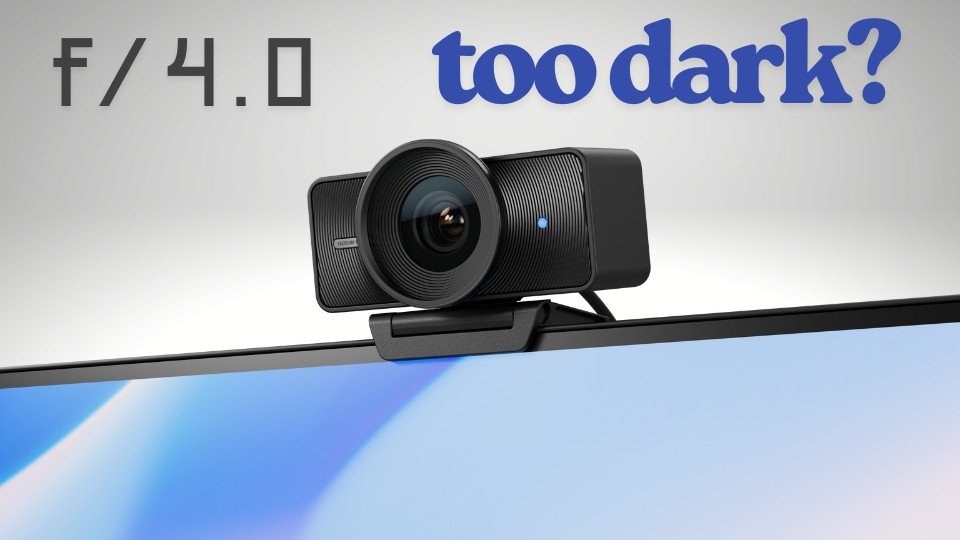Links in this post may be affiliate links. Any products purchased through affiliate links may provide a small commission which helps to support the SemiPro Tech+Gear site and YouTube channel.
A new webcam that recently was launched by Elgato reminded me that (as much as I already knew this from my experience with professional cameras)…aperture is a critical consideration for any video setup, especially when you can’t change the lens on the camera in question.
Webcams are one such situation. Now if you’ve transitioned to the world of using a mirrorless camera as a webcam, you’ve left this problem in the dust. But for the rest of us still using a webcam for video conferencing, it’s easy to forget about tech specs and just shop for that “shiny new thing” every few years when new models pique your interest.
Elgato Drops a New Cam
The webcam that reminded me of the importance of aperture was their brand new Facecam 4k (MSRP $199). Here’s a quick exerpt from the press release:
…Facecam 4K captures Ultra HD video at 60 frames per second, twice the frame rate of competing webcams. It includes Camera Hub software, where creators can tune their look with DSLR-style control and a suite of cinematic effects, such as LUTs. It’s also the first webcam to support lens filters…

I’ve been using the same webcam for about three years and thought “for $200 this might be worth a try”. The sensor is larger than my old webcam at 1/1.8″ and I liked the idea of being able to customize the settings and save them to the camera using the Elgato Camera Hub app. The ability to use 49mm camera filters was a bonus and I was curious to check it out with a PolarPro Everyday CPL+Mist filter. So I went ahead and ordered one.
Welp, There’s Your Problem
But as soon as I got the Facecam 4K set up I immediately realized I had forgotten to check the camera’s fixed aperture. And that’s the main downside of this new camera: it has a fixed f/4.0 aperture. That’s quite dark for a webcam these days. My previous webcam has an f/1.8 aperture, and the difference between the two is significant, especially if you don’t use dedicated lighting like me. Now unfortunately, I already returned the Facecam 4K and I failed to capture a sample image from it (I should have known better, but I was too mad at myself for buying impulsively to think straight). So instead, here’s a comparison of a still from some video shot at f/1.8 and f/4.0 in my room with just the lamp that I always have on and no key light.The video settings were identical other than the aperture (Sony ZV-E10 II, 24fps, 1/50 shutter speed, ISO 800). No exposure adjustments were applied to the footage.


As you can see, without any changes to ISO, f/4.0 is way too dark in this situation. With the Facecam 4K set to manual exposure, I was unable to get a usable image with the ISO in the 800-1,000 range, which was already starting to introduce noise. When I put the Facecam 4K into auto-exposure mode, it bumped the ISO up so high that noise reduction caused the image quality to suffer quite a bit. It was bad enough that my old webcam looked significantly better.
Why Don’t You Just Improve Your Lighting?
As a content creator for the last few years, I’m well aware the answer to this problem is first and foremost to improve your lighting. The problem is that my day job requires me to be in multiple video calls per day with the camera on. We’re talking 4-5 hours of video calls per day, 3-4 days per week. It’s one thing for me to use a relatively bright key light when recording a 15-20 minute video, but to sit there for upwards of 15 hours per week with a light blasting in my face? I’m just not going to do it.
And just one more point about this – I did actually try turning on a small key light that I have on my desk, but the Facecam 4K was unable to get a good exposure at the ISO levels that have a tolerable amount of noise even with the light on. So even with a slight bump in the lighting on my face, I wasn’t able to get the quality that would justify spending $200 on it.
The Bottom Line
The point here is just as the title says…don’t forget that aperture is an important consideration when shopping for a webcam! Just because the webcam has a relatively good quality sensor and high resolution doesn’t mean it’s the right one for your setup, unless you’re open to adjusting your lighting. Unfortunately, the fixed f/4.0 aperture of the new Elgato Facecam 4K makes it a not great choice for darker setups where you don’t have good illumination of your face – and by good, I mean fairly bright. Other than that, it does have some nice features and I would have likely been happy with it had it offered a brighter f/2 or f/1.8 aperture.
Check out the Facecam 4K


